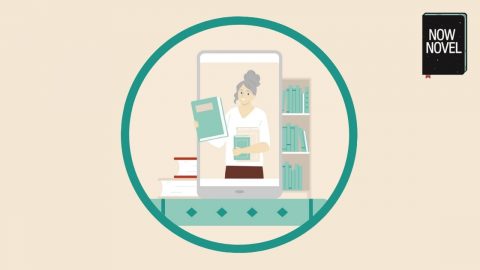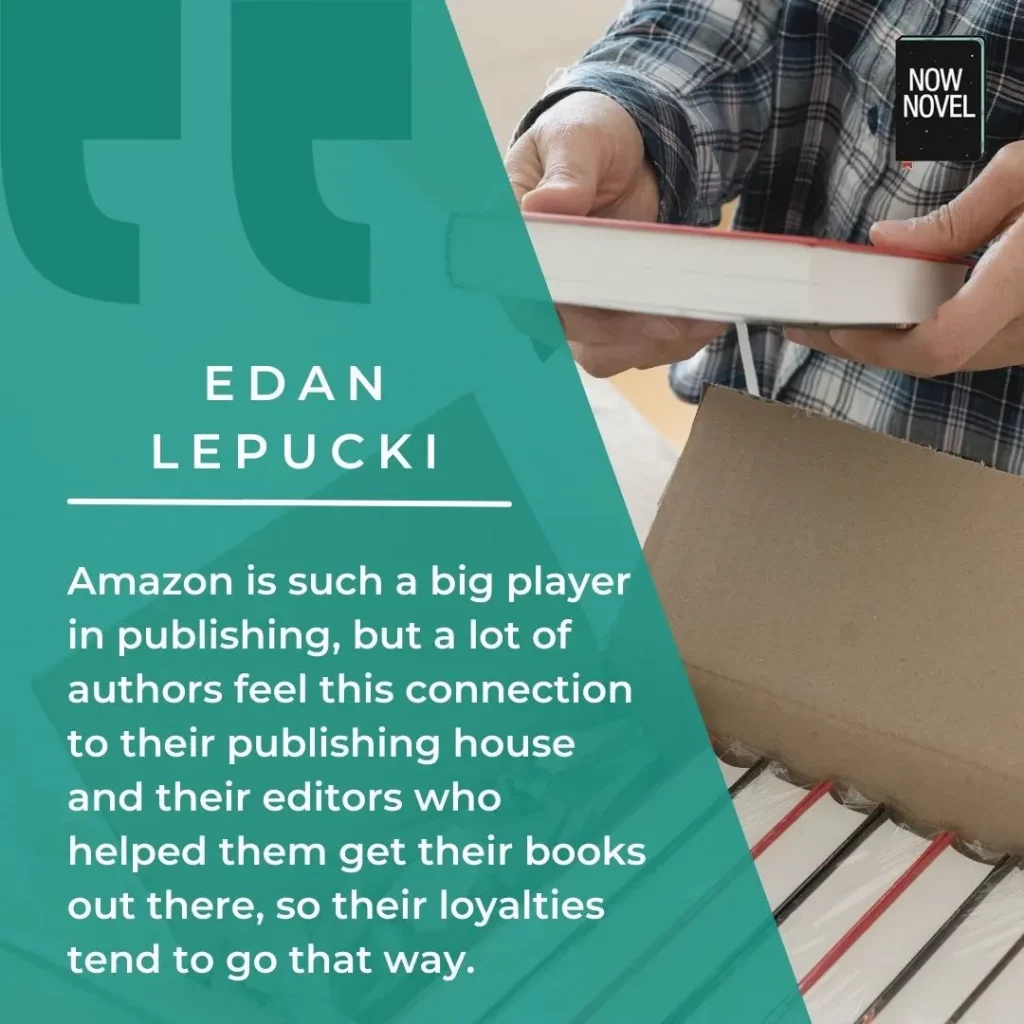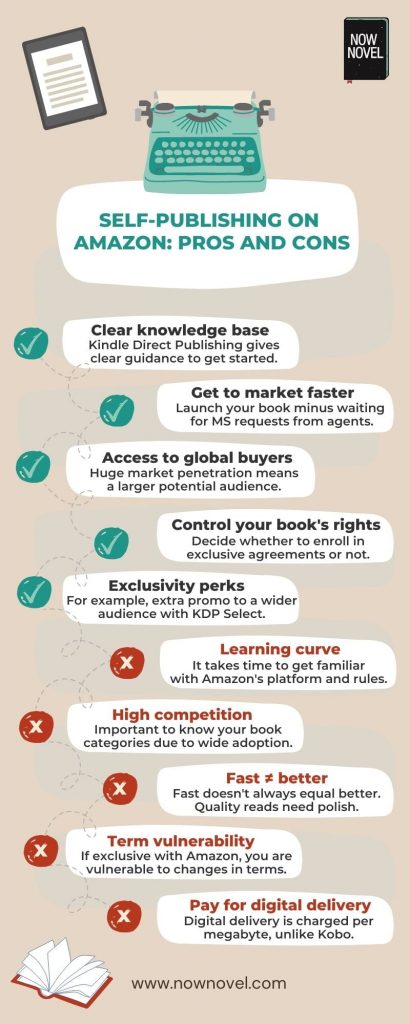Self-publishing on Amazon has pros and cons, like any path to publishing your book. Read pros and cons to help you make shrewder choices in your publishing journey:
10 pros of self-publishing on Amazon
- Good knowledge base and Amazon guides
- Get your book to market faster
- Access to global book buyers
- Maintain control of your book rights
- Going exclusive with Amazon gets you perks
- Flexible Amazon book pricing structure
- Structured book metadata and author pages aid discovery
- Two author royalty rates to choose between
- Sell and distribute physical copies multiple ways
- Digital avoids stock fulfillment issues
Let’s explore these ten pros of releasing books on Amazon for indie authors, after which we’ll examine ten cons, too:
Good knowledge base and Amazon guides
Publishing your own book may seem daunting if you have no prior experience.
Kindle Direct Publishing’s knowledge base is robust, though. Find sections on subjects such as book formatting, tax information for self-publishers, and more.
There are also many helpful guides for newbies. See Scribe Media’s step-by-step guide to setting up an author account on Amazon.
Get your book to market faster
In choosing between traditional and self-publishing, many indie authors choose self-publishing on Amazon for one reason: Getting to market faster.
Kindle Direct Publishing claims that you can publish in ‘less than 5 minutes’. They also state that ‘your book appears on Kindle stores worldwide within 24-48 hours’.
Now it’s no secret that traditional publishing takes time. Landing an agent who’ll shop your manuscript on your behalf means submitting query letters. It means crossing fingers for partial or full manuscript requests. There may be rejections with reasons given, as well as no reasons given.
Publishing your books on Amazon yourself takes time too, of course. Maybe not the claimed five minutes. If you’re writing to market, you need to do your research.
Yet Now Novel course alumni (such as author Dr Bonnie Traymore who we interviewed here) have managed to move from starting a book to publishing within six months. That time-frame is virtually unheard of in the traditional publishing space.
Master Amazon Self-Publishing
Weighing the pros and cons is crucial, and our Self-Publishing Packages are designed to tip the scales in your favor. With comprehensive services including manuscript editing, cover design, formatting, and an in-depth 21-week publishing course, we ensure your book stands out.
Start todayAccess to global book buyers
A third pro of self-publishing on Amazon is the potential scale of your reach.
Although Amazon’s market dominance has been flagged as anti-competitive (the UK’s Booksellers Association, for example, raised the negative impact this has on brick-and-mortar bookstores, in a 2020 report), the fact remains it offers indie authors a way to reach international readers, fast.
Although there is a learning curve to selling your books on Amazon, the barrier to entry is also low. You can also link audiobook versions of your titles to print and potentially scale revenue massively through this.
Maintain your book rights
How much of the rights to sell and market your book you give Amazon depends on your choices. Whether or not you enroll in their optional KDP Select program, for example, which requires 90 days’ exclusivity, renewing until cancelled.
All the above aside, the main thing is that you choose which opportunities you pursue as an indie author. Hybrid-published author and Now Novel writing coach Romy Sommer shares further benefits of being an indie author in this brief video:
Going exclusive with Amazon gets you perks
If you choose to enroll in Amazon’s KDP Select program when you self-publish, you get certain perks. These include:
- Inclusion in Amazon’s Kindle Unlimited program – like Netflix for books, readers get access to your books as part of a subscription package and you are paid per pages read
- Inclusion in Amazon’s Kindle Owners Lending Library (members may borrow one book per month, the royalty payment scheme being the same as KU)
- Opportunity to use additional promotional tools such as limited-time discount offers to boost sales
- The option to receive a 70% royalty rate for sales in India, Brazil, Mexico and Japan (versus Amazon’s other 35% royalty rate)
This is not only a pro, though, as the KDP Select program has its own pros and cons. Digital exclusivity means, for example, you can’t sell digital copies of your books via other publishing platforms.
If you have a large mailing list and this could be a good revenue contributor, it’s worth asking whether Amazon’s perks are worth not being able to market via other channels.
The industry term for multi-channel bookselling is ‘going wide’.

Prepare to launch your book
Join a course led by multi-published authors
and learn how to publish and promote your book.
Flexible Amazon book pricing structure
Another perk of self publishing on Amazon is flexibility in determining your pricing.
One common book pricing strategy, when writing a series, is to list the first title cheaper as a ‘lead magnet’ that draws readers to give your series a chance.
Note that if you want to be eligible for Amazon’s 70% revenue split option (where you keep 70% less tax and delivery costs instead of 35%), your book has to be priced between $2.99 and $9.99 (leading some to accuse Amazon of anti-competitive ‘price-fixing’).
Structured book metadata and author pages aid discovery
A pro of self-publishing your book on Amazon is that it offers organized ways to make your books easier to discover for the right readers.
Your book’s metadata, including genre category and subcategories to front and back page matter, an ISBN number, your book’s blurb and plugs (review snippets), may all be uploaded. Each book on Amazon’s platform also gets a unique ASIN number.
These discoverable elements aren’t all unique to Amazon’s merchant platform, of course – many online booksellers have searchable databases. Yet Amazon’s well-organized product data means you can get more visibility in creative ways if you understand, for example, how to choose the right categories for your books.
Look at the Amazon author pages of successful authors such as Colleen Hoover to get a sense of how to create a compelling author page with relevant biographical data.
Two author royalty rates to choose between
When self publishing on Amazon, pros and cons include pricing. One pro is that you are not locked to one royalty rate agreement indefinitely.
If you price your book very low (below $2.99) or higher than Amazon’s threshold of $9.99, you get 35% of each sale (after vat and delivery cost deductions). Yet there is a list of 37 countries (as of 2022) where you can get 70% of each Amazon sale (before deductions), provided that you satisfy Amazon’s requirements.
These include making your digital copies at least 20% cheaper than any physical edition you list.
Sell and distribute physical copies multiple ways
A further pro to using Amazon’s platform to self publish your books: Multiple ways to fulfil physical orders.
You can either use Amazon purely as a marketplace and fulfil orders yourself (which means packing and mailing orders), or you can have Amazon fulfil orders on your behalf.
Amazon gives specific guidelines for its expanded book distribution program, whereby you can sell physical editions of your book to libraries and booksellers.
Read more about book distribution basics in our guide to physical and digital distribution.
Digital avoids stock fulfilment issues
Many indie authors focus on digital due to having fewer logistical challenges to solve.
A final pro of selling your self-published book via Amazon’s KDP platform (or any other digital platform) is that you don’t need to worry about order fulfilment – it’s all automatic. No emailing readers purchased copies like it’s 1990.
This is more important than ever, given the global shortages there have been in recent years due to the pandemic and other factors affecting global supply chains of everything from computer chips to paper. We wrote about this previously in discussing publishing trends in 2022.
10 cons of self-publishing on Amazon
- Moderate learning curve
- High competition in many categories
- Fast time to market allows rushed launch
- Vulnerability to changes in Amazon’s terms
- Limited recourse for disputes over blocks
- Higher royalty rate may require KDP Select
- Royalties are VAT-exclusive
- Fewer ways to build relationships with readers
- Higher visibility requires many reviews
- You pay per book for digital delivery
We’ve looked at some of the pros of self-publishing on Amazon. Now for the platform’s cons:
Moderate learning curve
Any new tool or platform has a learning curve. Understanding how to use Amazon’s platform to full advantage takes a little time. The advantage of publishing traditionally is you don’t have to think as much about logistics (though publishers will expect you to aid in promoting your work).
High competition in many categories
Because of Amazon’s global reach and market domination, and the low barrier to entry for indie authors, there is naturally lots of competition.
Competition is more of an obstacle to visibility than a con, as it is inevitable. It is a con if you don’t know what categories to choose, or pick an oversaturated book category and subcategory.
Fast time to market allows rushed launch
We listed fast time to market as a pro of self-publishing via Amazon above. Yet it is double-edged – this feature may also prove an issue. Why?
When you can get your book out quickly, you may be tempted to skip crucial steps such as building a robust marketing plan (or worse, not investing in professional editing).
A con of an easy platform is that it can encourage authors to skimp in some areas of successful launch prep. Ensure you take steps vital for good reviews and sales. Good quality, good promotion.
Vulnerability to changes in Amazon’s terms
Whatever platform you choose to self-publish your book with, you are bound by that platform’s terms.
This is a vulnerability, especially if you go exclusive. What if you’re selling X copies per month, for example, and Amazon suddenly makes a change that causes your books’ visibility to plummet?
You will find authors’ accounts of their books being pulled from being listed due to bugs and other issues online. These are reasonable arguments for going wide, so all your pages aren’t in one basket.
Limited recourse for disputes or issues
A challenge with any big company is you may struggle to get assistance with issues. For example, a book you’ve listed being removed in error, or reviews disappearing.
Amazon KDP’s TrustPilot review average isn’t amazing, either, but given how many authors publish on the platform versus the number of negative reviews, poor experiences may be isolated incidents more than the norm.
Higher royalty rate may require KDP select
Qualifying for the higher 70% royalty rate is not a given for every region. To qualify for this rate in India, Brazil, Mexico and Japan you have to enroll in KDP Select (at time of writing).
For a helpful breakdown of Amazon’s different author royalty rates, see Author Imprints’ guide.
Royalties are VAT-exclusive
Want to calculate what your gross profit will be for each book you sell on Amazon? KDP gives this formula (for Amazon’s lower royalty rate):
35% Royalty Rate x (List Price – applicable VAT) = Royalty.
Amazon also charges delivery fees for digital books (more on this below). Remember to factor in these costs when working out how many books you need to sell to break even.
Fewer ways to build relationships with readers
If you compare Amazon author pages with a platform such as Goodreads, it is clear the latter serves building relationships with readers better.
Amazon is a merchant/marketplace, first. On Goodreads, your readers can ask you questions, direct from your author page. Buyers can at least follow your Amazon author page, however, to receive alerts whenever you list new publications.
Even if you go exclusive with Amazon, it is thus wise to build your author website and Goodreads page. Post regularly to your social channels too to connect with future fans.
Higher visibility requires many reviews
In a HuffPost article from 2017, Brooke Warner writes about how crucial reviews are for gaining visibility on Amazon.
Fifty reviews, shares Warner, is the number required for Amazon to start noticing your book for further boosting. This is why it’s wise to create a strong promo plan (including review swaps and other ways to get public feedback) before you hit ‘publish’.
Now Novel coaching alumnus Travis Beaudoin has 200 reviews and counting on his March 2022 LGBT romance title, Too Like the Lightning. The author already had an established readership from prior titles in the series, however. There thus was an existing reviewer base for the book.
You pay per book for digital delivery
The final con (or challenge) of self publishing on Amazon is that you pay a small fee for digital delivery. This contrasts with platforms such as Kobo. Kobo states in its FAQ that it does not charge to delivery digital books.
The self publishing on Amazon pros and cons given above give a broad idea of the platform. For insights and structured guidance to launching your book from authors and publishing consultants, join How to Publish and Promo your Novel. Here is a detailed general look at the pros and cons of self-publishing.




